#i199
Photo

Challenge #03487-I199: And Your Choice of Dipping Sauce
A group of humans invite a large group of Vorax, as well as other factions of their kind, such as the farmers, the factory workers and so forth, to a huge planet that's a foodie paradise. Shelling out the time to take them to an all-you-can-eat-high-calorie-lots-of-meat buffet. Why? Just for the fun of it. -- Anon Guest
It's not often that one invites the enemy to a dinner date. Neither side was truly prepared, but the Humans knew how to do peace after lifetimes of war. This was not helped by the fact that the Vorax as a species had metabolisms like the heart of a star.
They needed high calorie food like most species needed air or water.
The planet for the feast was far away from anywhere else in the greater Galactic Alliance. Initially an uninhabited Havenworld, Humanity turned it into extravagantly abundant farmland, and thereafter, food. Humans, it must be noted, have made a lifestyle out of calorie-dense creations that would appall all but the hungriest of cogniscents.
[Check the source for the rest of the story]
3 notes
·
View notes
Photo

Challenge #03487-I199: And Your Choice of Dipping Sauce
A group of humans invite a large group of Vorax, as well as other factions of their kind, such as the farmers, the factory workers and so forth, to a huge planet that's a foodie paradise. Shelling out the time to take them to an all-you-can-eat-high-calorie-lots-of-meat buffet. Why? Just for the fun of it. -- Anon Guest
It's not often that one invites the enemy to a dinner date. Neither side was truly prepared, but the Humans knew how to do peace after lifetimes of war. This was not helped by the fact that the Vorax as a species had metabolisms like the heart of a star.
They needed high calorie food like most species needed air or water.
The planet for the feast was far away from anywhere else in the greater Galactic Alliance. Initially an uninhabited Havenworld, Humanity turned it into extravagantly abundant farmland, and thereafter, food. Humans, it must be noted, have made a lifestyle out of calorie-dense creations that would appall all but the hungriest of cogniscents.
[Check the source for the rest of the story]
3 notes
·
View notes
Photo


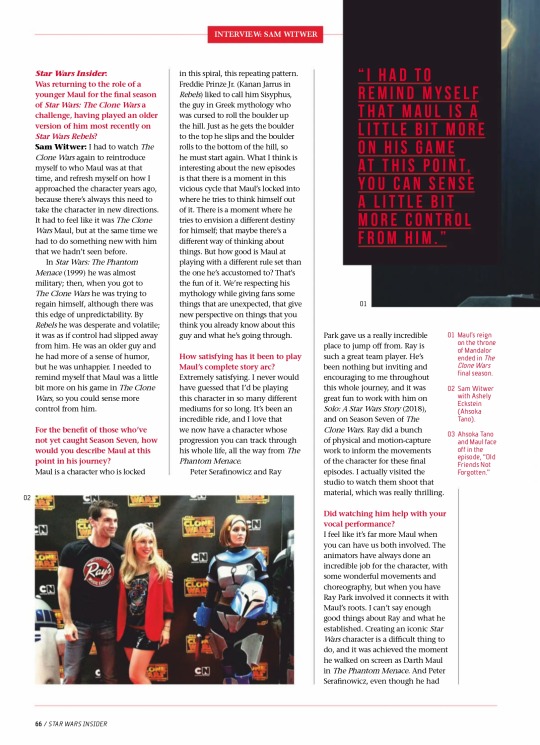
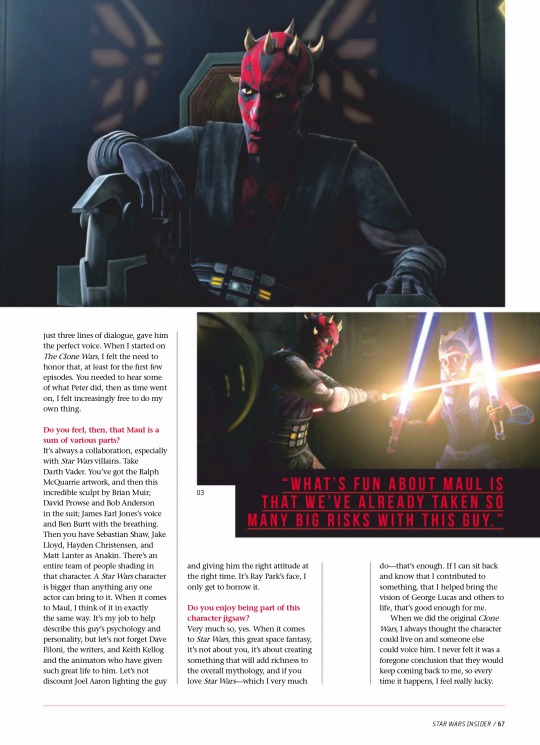
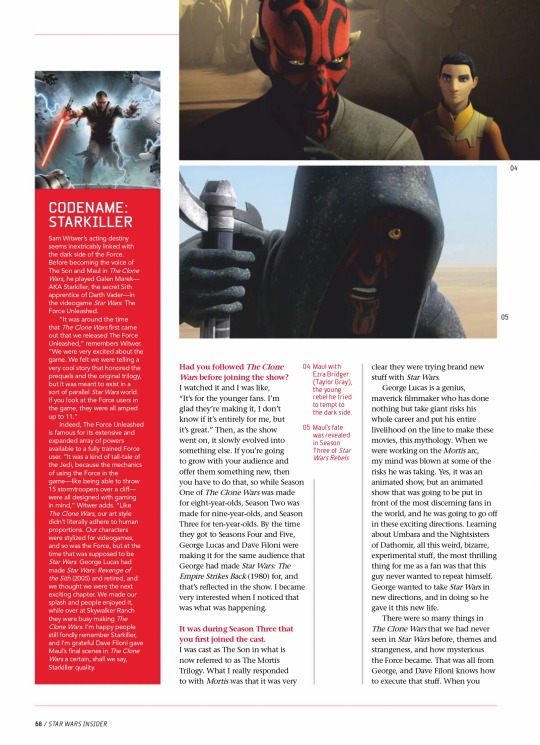
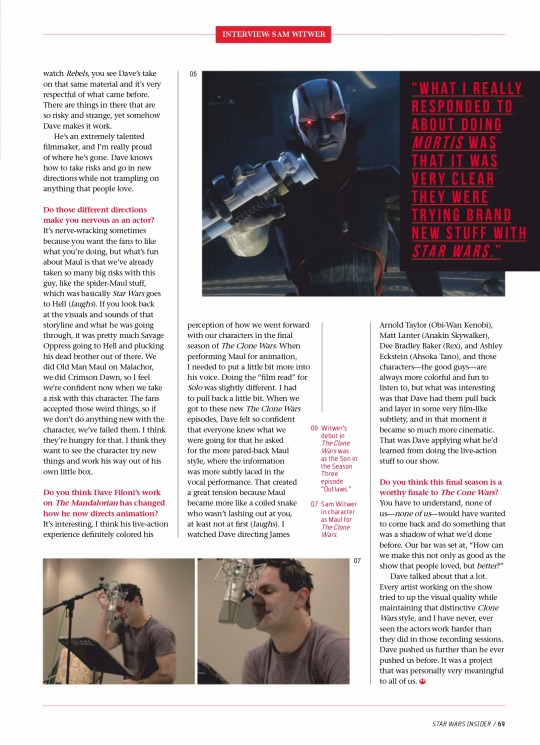
SAM WITWER UNLEASHED! (#199, DEC 2020)
Insider talks to the actor who has taken Maul from sliced-in-two Sith to his demise in the deserts of Tatooine. Words: Mark Newbold
Star Wars Insider: Was returning to the role of a younger Maul for the final season of Star Wars: The Clone Wars a challenge, having played an older version of him most recently on Star Wars Rebels?
Sam Witwer: I had to watch The Clone Wars again to reintroduce myself to who Maul was at that time, and refresh myself on how I approached the character years ago, because there’s always this need to take the character in new directions. It had to feel like it was The Clone Wars Maul, but at the same time we had to do something new with him that we hadn’t seen before.
In Star Wars: The Phantom Menace (1999) he was almost military; then, when you got to The Clone Wars he was trying to regain himself, although there was this edge of unpredictability. By Rebels he was desperate and volatile; it was as if control had slipped away from him. He was an older guy and he had more of a sense of humor, but he was unhappier. I needed to remind myself that Maul was a little bit more on his game in The Clone Wars, so you could sense more control from him.
For the benefit of those who’ve not yet caught Season Seven, how would you describe Maul at this point in his journey?
Maul is a character who is locked in this spiral, this repeating pattern. Freddie Prinze Jr. (Kanan Jarrus in Rebels) liked to call him Sisyphus, the guy in Greek mythology who was cursed to roll the boulder up the hill. Just as he gets the boulder to the top he slips and the boulder rolls to the bottom of the hill, so he must start again. What I think is interesting about the new episodes is that there is a moment in this vicious cycle that Maul’s locked into where he tries to think himself out of it. There is a moment where he tries to envision a different destiny for himself; that maybe there’s a different way of thinking about things. But how good is Maul at playing with a different rule set than the one he’s accustomed to? That’s the fun of it. We’re respecting his mythology while giving fans some things that are unexpected, that give new perspective on things that you think you already know about this guy and what he’s going through.
How satisfying has it been to play Maul’s complete story arc?
Extremely satisfying. I never would have guessed that I’d be playing this character in so many different mediums for so long. It’s been an incredible ride, and I love that we now have a character whose progression you can track through his whole life, all the way from The Phantom Menace.
Peter Serafinowicz and Ray Park gave us a really incredible place to jump off from. Ray is such a great team player. He’s been nothing but inviting and encouraging to me throughout this whole journey, and it was great fun to work with him on Solo: A Star Wars Story (2018), and on Season Seven of The Clone Wars. Ray did a bunch of physical and motion-capture work to inform the movements of the character for these final episodes. I actually visited the studio to watch them shoot that material, which was really thrilling.
Did watching him help with your vocal performance?
I feel like it’s far more Maul when you can have us both involved. The animators have always done an incredible job for the character, with some wonderful movements and choreography, but when you have Ray Park involved it connects it with Maul’s roots. I can’t say enough good things about Ray and what he established. Creating an iconic Star Wars character is a difficult thing to do, and it was achieved the moment he walked on screen as Darth Maul in The Phantom Menace. And Peter Serafinowicz, even though he had just three lines of dialogue, gave him the perfect voice. When I started on The Clone Wars, I felt the need to honor that, at least for the first few episodes. You needed to hear some of what Peter did, then as time went on, I felt increasingly free to do my own thing.
Do you feel, then, that Maul is a sum of various parts?
It’s always a collaboration, especially with Star Wars villains. Take Darth Vader. You’ve got the Ralph McQuarrie artwork, and then this incredible sculpt by Brian Muir; David Prowse and Bob Anderson in the suit; James Earl Jones’s voice and Ben Burtt with the breathing. Then you have Sebastian Shaw, Jake Lloyd, Hayden Christensen, and Matt Lanter as Anakin. There’s an entire team of people shading in that character. A Star Wars character is bigger than anything any one actor can bring to it. When it comes to Maul, I think of it in exactly the same way. It’s my job to help describe this guy’s psychology and personality, but let’s not forget Dave Filoni, the writers, and Keith Kellog and the animators who have given such great life to him. Let’s not discount Joel Aaron lighting the guy and giving him the right attitude at the right time. It’s Ray Park’s face, I only get to borrow it
Do you enjoy being part of this character jigsaw?
Very much so, yes. When it comes to Star Wars, this great space fantasy, it’s not about you, it’s about creating something that will add richness to the overall mythology, and if you love Star Wars—which I very much do—that’s enough. If I can sit back and know that I contributed to something, that I helped bring the vision of George Lucas and others to life, that’s good enough for me.
When we did the original Clone Wars, I always thought the character could live on and someone else could voice him. I never felt it was a foregone conclusion that they would keep coming back to me, so every time it happens, I feel really lucky.
Had you followed The Clone Wars before joining the show?
I watched it and I was like, “It’s for the younger fans. I’m glad they’re making it, I don’t know if it’s entirely for me, but it’s great.” Then, as the show went on, it slowly evolved into something else. If you’re going to grow with your audience and offer them something new, then you have to do that, so while Season One of The Clone Wars was made for eight-year-olds, Season Two was made for nine-year-olds, and Season Three for ten-year-olds. By the time they got to Seasons Four and Five, George Lucas and Dave Filoni were making it for the same audience that George had made Star Wars: The Empire Strikes Back (1980) for, and that’s reflected in the show. I became very interested when I noticed that was what was happening.
It was during Season Three that you first joined the cast.
I was cast as The Son in what is now referred to as The Mortis Trilogy. What I really responded to with Mortis was that it was very clear they were trying brand new stuff with Star Wars.
George Lucas is a genius, maverick filmmaker who has done nothing but take giant risks his whole career and put his entire livelihood on the line to make these movies, this mythology. When we were working on the Mortis arc, my mind was blown at some of the risks he was taking. Yes, it was an animated show, but an animated show that was going to be put in front of the most discerning fans in the world, and he was going to go off in these exciting directions. Learning about Umbara and the Nightsisters of Dathomir, all this weird, bizarre, experimental stuff, the most thrilling thing for me as a fan was that this guy never wanted to repeat himself. George wanted to take Star Wars in new directions, and in doing so he gave it this new life.
There were so many things in The Clone Wars that we had never seen in Star Wars before, themes and strangeness, and how mysterious the Force became. That was all from George, and Dave Filoni knows how to execute that stuff. When you watch Rebels, you see Dave’s take on that same material and it’s very respectful of what came before. There are things in there that are so risky and strange, yet somehow Dave makes it work.
He’s an extremely talented filmmaker, and I’m really proud of where he’s gone. Dave knows how to take risks and go in new directions while not trampling on anything that people love.
Do those different directions make you nervous as an actor?
It’s nerve-wracking sometimes because you want the fans to like what you’re doing, but what’s fun about Maul is that we’ve already taken so many big risks with this guy, like the spider-Maul stuff, which was basically Star Wars goes to Hell (laughs). If you look back at the visuals and sounds of that storyline and what he was going through, it was pretty much Savage Oppress going to Hell and plucking his dead brother out of there. We did Old Man Maul on Malachor, we did Crimson Dawn, so I feel we’re confident now when we take a risk with this character. The fans accepted those weird things, so if we don’t do anything new with the character, we’ve failed them. I think they’re hungry for that. I think they want to see the character try new things and work his way out of his own little box.
Do you think Dave Filoni’s work on The Mandalorian has changed how he now directs animation?
It’s interesting, I think his live-action experience definitely colored his perception of how we went forward with our characters in the final season of The Clone Wars. When performing Maul for animation, I needed to put a little bit more into his voice. Doing the “film read” for Solo was slightly different. I had to pull back a little bit. When we got to these new The Clone Wars episodes, Dave felt so confident that everyone knew what we were going for that he asked for the more pared-back Maul style, where the information was more subtly laced in the vocal performance. That created a great tension because Maul became more like a coiled snake who wasn’t lashing out at you, at least not at first (laughs). I watched Dave directing James Arnold Taylor (Obi-Wan Kenobi), Matt Lanter (Anakin Skywalker), Dee Bradley Baker (Rex), and Ashley Eckstein (Ahsoka Tano), and those characters—the good guys—are always more colorful and fun to listen to, but what was interesting was that Dave had them pull back and layer in some very film-like subtlety, and in that moment it became so much more cinematic. That was Dave applying what he’d learned from doing the live-action stuff to our show.
Do you think this final season is a worthy finale to The Clone Wars?
You have to understand, none of us—none of us—would have wanted to come back and do something that was a shadow of what we’d done before. Our bar was set at, “How can we make this not only as good as the show that people loved, but better?”
Dave talked about that a lot. Every artist working on the show tried to up the visual quality while maintaining that distinctive Clone Wars style, and I have never, ever seen the actors work harder than they did in those recording sessions. Dave pushed us further than he ever pushed us before. It was a project that was personally very meaningful to all of us.
CODENAME: STARKILLER
Sam Witwer’s acting destiny seems inextricably linked with the dark side of the Force. Before becoming the voice of The Son and Maul in The Clone Wars, he played Galen Marek— AKA Starkiller, the secret Sith apprentice of Darth Vader—in the videogame Star Wars: The Force Unleashed.
“It was around the time that The Clone Wars first came out that we released The Force Unleashed,” remembers Witwer. “We were very excited about the game. We felt we were telling a very cool story that honored the prequels and the original trilogy, but it was meant to exist in a sort of parallel Star Wars world. If you look at the Force users in the game, they were all amped up to 11.”
Indeed, The Force Unleashed is famous for its extensive and expanded array of powers available to a fully trained Force user. “It was a kind of tall-tale of the Jedi, because the mechanics of using the Force in the game—like being able to throw 15 stormtroopers over a cliff— were all designed with gaming in mind,” Witwer adds. “Like The Clone Wars, our art style didn’t literally adhere to human proportions. Our characters were stylized for videogames, and so was the Force, but at the time that was supposed to be Star Wars. George Lucas had made Star Wars: Revenge of the Sith (2005) and retired, and we thought we were the next exciting chapter. We made our splash and people enjoyed it, while over at Skywalker Ranch they were busy making The Clone Wars. I’m happy people still fondly remember Starkiller, and I’m grateful Dave Filoni gave Maul’s final scenes in The Clone Wars a certain, shall we say, Starkiller quality.”
306 notes
·
View notes
Photo
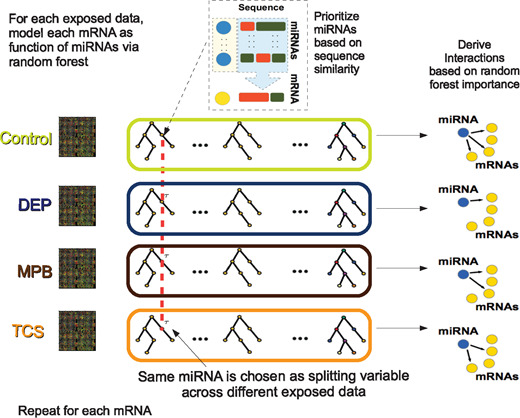
A new method to study the change of miRNA–mRNA interactions due to environmental exposures. Petralia et al, Bioinformatics (2017) 33 (14): i199-i207.
0 notes
Link
May xưởng gia công nơ áo phủ ghế đẹp được sử dụng ngày nay không chỉ trong các sự kiện, gia đình mà còn được sử dụng rộng rãi ở các buổi họp cty, hội thảo, cưới hỏi. Nơ trùm ghế trở thành áo ghế được ưa chuộng nhiều trên thị trường nơ áo phủ ghế việt. Nơ áo váy ghế được người tiêu dùng yêu thích và tìm mua để trang trí cho các nhà hàng hay không gian lớn với kích thước, màu sắc, hoa văn, kiểu dáng phong phú. Nơ được thiết kế với nhiều kích thước, hình dạng khác nhau nên được sử dụng đa dạng trong nhiều không gian khác nhau. Tùy vào màu sắc, nội thất trong không gian mà bạn chọn nơ váy ghế sao cho phù hợp, toát lên được phong cách.
0 notes
Photo

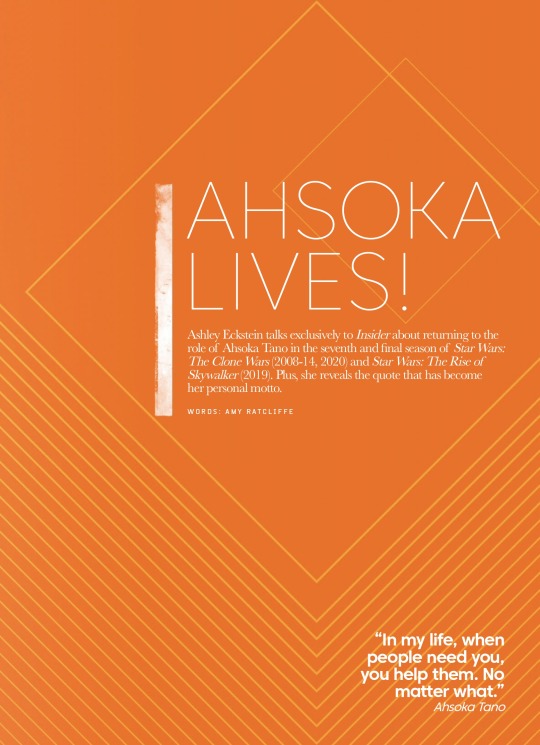

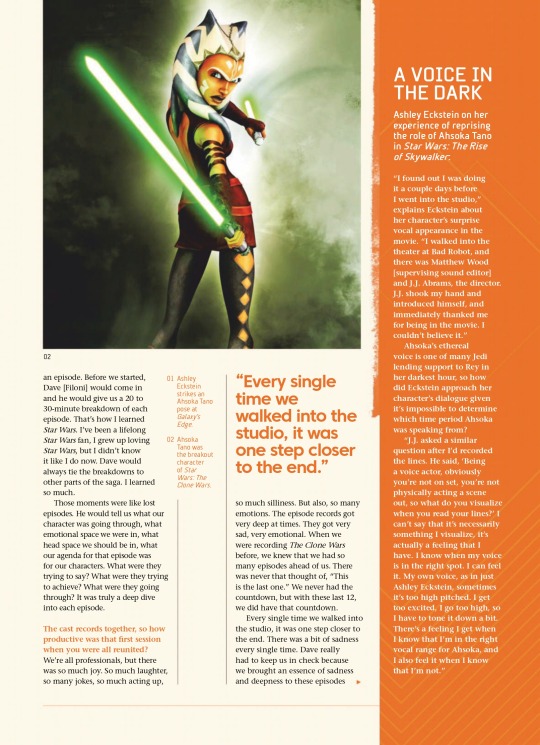
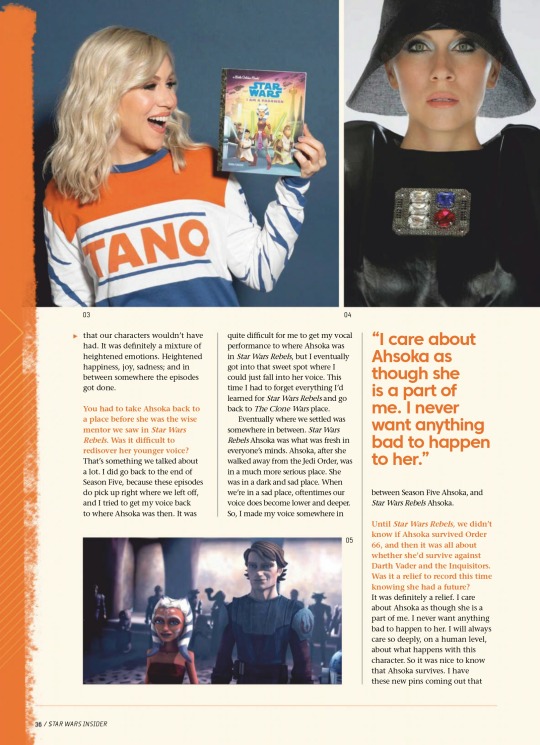

AHSOKA LIVES! (#199, DEC 2020)
Ashley Eckstein talks exclusively to Insider about returning to the role of Ahsoka Tano in the seventh and final season of Star Wars: The Clone Wars (2008-14, 2020) and Star Wars: The Rise of Skywalker (2019). Plus, she reveals the quote that has become her personal motto. Words: Amy Ratcliffe
Star Wars: The Clone Wars’ final season brought back Ahsoka Tano—an Ahsoka we haven’t seen before. Although it’s been seven years since we watched her walk away from the Jedi Order in the show’s season five finale, only a short time had passed in the galaxy far, far away, and the character is still coping with that huge upheaval in her life. Insider spoke with the actress about Ahsoka’s long-awaited return.
Star Wars Insider: Fans were so surprised to hear about the return of The Clone Wars. How did you react when you heard the news?
Ashley Eckstein: I first heard about it from Dee Bradley Baker. I was at Disney World riding rides with my husband, and I got this text message. I knew that Dee was wine tasting with the Star Wars Rebels (2014-2018) cast and that Dave Filoni was there, so when he sent me the text message and he said, “Clone Wars, 12 episodes coming back,” I didn’t believe it. I was like, “That is top secret news.”
So it wasn’t something you expected to hear in a text message?
I forget exactly how the text chain unfolded, but Dee was like, “No, no, for real. This is happening.” Of course, I was excited because if Dee is telling me that it’s for real, then I want to believe him because he is like a brother to me.
I heard from my agent next, and I still didn’t believe it. I said, “Wait a minute, I haven’t heard it from Dave. This can’t be real.” So, I called Dave and he said, “Hey, what’s going on?” I said, “Do you have something to tell me?” Dave felt really bad. He said that wasn’t how he wanted me to find out, but that it was true, and I was so excited. I didn’t fully believe it until I heard it from Dave Filoni.
How emotional was it to know that you’d be coming back?
When The Clone Wars was canceled, it was so sad. We didn’t get the proper goodbye. We didn’t get that final recording session or that happy wrap party. So, I took The Clone Wars, locked it in a place in my heart, and I threw away the key. I was so hurt and didn’t want to allow anyone to hurt us again. When I found out that it was happening, I was in absolute disbelief. Obviously Dave Filoni was crucial to it, but one person that is the unsung hero, that is not getting the credit that she deserves, is Carrie Beck (vice president of animation and live-action development at Lucasfilm Ltd). I’m forever grateful to the fans for not giving up, I’m forever grateful to Carrie Beck for believing that it could come back, I’m forever grateful to Dave Filoni for getting the gang back together, and I’m forever grateful to Disney+ for giving it a home.
You mentioned the fans never giving up. They threw their all into the “Save The Clone Wars” campaign for years, and now it’s #CloneWarsSaved. Did it warm your heart to see that support over the years?
Yes. Though I’m usually a very, very positive person, I was not so positive about The Clone Wars. I never thought it would ever come back. It’s kind of ironic that the last fortune cookie caption for the last episode in which Ahsoka had appeared was, “Never give up hope, no matter how dark things seem.” The fans never gave up hope. They always had hope that The Clone Wars would be saved, and here we are. They took that very last fortune cookie to heart.
What conversations did you have with Dave Filoni about Ahsoka’s return to the screen?
They always happened in the studio right before we would record an episode. Before we started, Dave [Filoni] would come in and he would give us a 20 to 30-minute breakdown of each episode. That’s how I learned Star Wars. I’ve been a lifelong Star Wars fan, I grew up loving Star Wars, but I didn’t know it like I do now. Dave would always tie the breakdowns to other parts of the saga. I learned so much.
Those moments were like lost episodes. He would tell us what our character was going through, what emotional space we were in, what head space we should be in, what our agenda for that episode was for our characters. What were they trying to say? What were they trying to achieve? What were they going through? It was truly a deep dive into each episode.
The cast records together, so how productive was that first session when you were all reunited?
We’re all professionals, but there was so much joy. So much laughter, so many jokes, so much acting up, so much silliness. But also, so many emotions. The episode records got very deep at times. They got very sad, very emotional. When we were recording The Clone Wars before, we knew that we had so many episodes ahead of us. There was never that thought of, “This is the last one.” We never had the countdown, but with these last 12, we did have that countdown.
Every single time we walked into the studio, it was one step closer to the end. There was a bit of sadness every single time. Dave really had to keep us in check because we brought an essence of sadness and deepness to these episodes that our characters wouldn’t have had. It was definitely a mixture of heightened emotions. Heightened happiness, joy, sadness; and in between somewhere the episodes got done.
You had to take Ahsoka back to a place before she was the wise mentor we saw in Star Wars Rebels. Was it difficult to redisover her younger voice?
That’s something we talked about a lot. I did go back to the end of Season Five, because these episodes do pick up right where we left off, and I tried to get my voice back to where Ahsoka was then. It was quite difficult for me to get my vocal performance to where Ahsoka was in Star Wars Rebels, but I eventually got into that sweet spot where I could just fall into her voice. This time I had to forget everything I’d learned for Star Wars Rebels and go back to The Clone Wars place.
Eventually where we settled was somewhere in between. Star Wars Rebels Ahsoka was what was fresh in everyone’s minds. Ahsoka, after she walked away from the Jedi Order, was in a much more serious place. She was in a dark and sad place. When we’re in a sad place, oftentimes our voice does become lower and deeper. So, I made my voice somewhere in between Season Five Ahsoka, and Star Wars Rebels Ahsoka.
Until Star Wars Rebels, we didn’t know if Ahsoka survived Order 66, and then it was all about whether she’d survive against Darth Vader and the Inquisitors. Was it a relief to record this time knowing she had a future?
It was definitely a relief. I care about Ahsoka as though she is a part of me. I never want anything bad to happen to her. I will always care so deeply, on a human level, about what happens with this character. So it was nice to know that Ahsoka survives. I have these new pins coming out that illustrator Karen Hallion has done the art for. I picked a word for each character, and for Ahsoka, it was very important to me that her word was “survivor” because while we always say “Ahsoka lives,” actually Ahsoka survives. No matter what, against all odds, Ahsoka survives. It’s nice to know that she made it through The Clone Wars.
Ahsoka has an incredible line in her return that feels very symbolic of her character: “In my life, when people need you, you help them. No matter what.” Does that quote resonate with you?
There’s a whole story behind this line, and it blows my mind how this came full circle. We’re not allowed to keep our scripts; when we leave the recording studio, we have to leave them with Lucasfilm, but when I read that line as I was recording the episode, something came over me. I said, “This line. This line is going to be my personal motto for the new season and for 2020.” I broke a rule, and I took a screenshot of the line. That’s all I have. It’s just a screenshot of the line only—I cut out the rest of the page because I didn’t want to be responsible for having a page from the script. When I read that line I said, “That’s it. That is going to be my personal motto.”
I wanted to do good with it and help people no matter what. I started working on a new Jedi training program for children that focuses on mindfulness, and I’ve been working with Disney and Lucasfilm to bring this program to children’s hospitals all over the nation. Ahsoka is teaching us that lesson, to help people no matter what. I got goosebumps all over when I recorded that line. I knew it was important, but at the time I had no idea how important it was going to become.
What would you say ties the final season to its predecessors, especially in terms of your character?
It picks up on the theme that ran through The Clone Wars: Never give up hope, no matter how dark things seem. When it feels like hope is gone, there’s always hope. All these episodes include beautiful examples of friendship; whether it’s between Ahsoka, Trace, and Rafa, or between Ahsoka and Captain Rex. They’re beautiful stories about friendship and about helping each other.
For Ahsoka, they are so powerful. She really comes into her own in these episodes. If you think that what we’ve seen from Ahsoka up to now is that she always wants to do what’s right, boy do you see that in these episodes. Literally, when she doesn’t have to, when everyone is telling her not to, Ahsoka doesn’t compromise who she is. It’s just so powerful.
I changed the hashtag—well, not exactly changed because I still use #AhsokaLives all the time, but I added to the hashtag, #AhsokaLivesInAllOfUs. Especially after these episodes, there’s so much we can take away from her. She’s passed on all these lessons now, after so many years. I think it’s our job to continue her legacy. It’s up to all of us. Ahsoka truly lives in all of us.
A VOICE IN THE DARK
Ashley Eckstein on her experience of reprising the role of Ahsoka Tano in Star Wars: The Rise of Skywalker: “I found out I was doing it a couple days before I went into the studio,” explains Eckstein about her character’s surprise vocal appearance in the movie. “I walked into the theater at Bad Robot, and there was Matthew Wood [supervising sound editor] and J.J. Abrams, the director. J.J. shook my hand and introduced himself, and immediately thanked me for being in the movie. I couldn’t believe it.”
Ahsoka’s ethereal voice is one of many Jedi lending support to Rey in her darkest hour, so how did Eckstein approach her character’s dialogue given it’s impossible to determine which time period Ahsoka was speaking from?
“J.J. asked a similar question after I’d recorded the lines. He said, ‘Being a voice actor, obviously you’re not on set, you’re not physically acting a scene out, so what do you visualize when you read your lines?’ I can’t say that it’s necessarily something I visualize, it’s actually a feeling that I have. I know when my voice is in the right spot. I can feel it. My own voice, as in just Ashley Eckstein, sometimes it’s too high pitched. I get too excited, I go too high, so I have to tone it down a bit. There’s a feeling I get when I know that I’m in the right vocal range for Ahsoka, and I also feel it when I know that I’m not.”
171 notes
·
View notes
Link
Check out this listing I just added to my Poshmark closet: APPROPRIATE BEHAVIOR. Graphic short sleeve size S.
0 notes
Link
Check out this listing I just added to my Poshmark closet: APPROPRIATE BEHAVIOR. Graphic short sleeve size S.
0 notes
Link
Check out this listing I just added to my Poshmark closet: APPROPRIATE BEHAVIOR. Graphic short sleeve size S.
0 notes
Link
Check out this listing I just added to my Poshmark closet: APPROPRIATE BEHAVIOR. Graphic short sleeve size S.
0 notes
Link
Check out this listing I just added to my Poshmark closet: APPROPRIATE BEHAVIOR. Graphic short sleeve size S.
0 notes
Link
Check out this listing I just added to my Poshmark closet: APPROPRIATE BEHAVIOR. Graphic short sleeve size S.
0 notes
Link
Check out this listing I just added to my Poshmark closet: APPROPRIATE BEHAVIOR. Graphic short sleeve size S.
0 notes